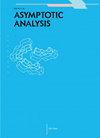The Euler–Poisswell/Darwin equation and the asymptotic hierarchy of the Euler–Maxwell equation
IF 0.9
4区 数学
Q2 MATHEMATICS, APPLIED
引用次数: 0
Abstract
In this paper we introduce the (unipolar) pressureless Euler–Poisswell equation for electrons as the O ( 1 / c ) semi-relativistic approximation and the (unipolar) pressureless Euler–Darwin equation as the O ( 1 / c 2 ) semi-relativistic approximation of the (unipolar) pressureless Euler–Maxwell equation. In the “infinity-ion-mass” limit, the unipolar Euler–Maxwell equation arises from the bipolar Euler–Maxwell equation, describing a coupled system for a plasma of electrons and ions. The non-relativistic limit c → ∞ of the Euler–Maxwell equation is the repulsive Euler–Poisson equation with electric force. We propose that the Euler–Poisswell equation, where the Euler equation with electric force is coupled to the magnetostatic O ( 1 / c ) approximation of Maxwell’s equations, is the correct semi-relativistic O ( 1 / c ) approximation of the Euler–Maxwell equation. In the Euler–Poisswell equation the fluid dynamics are decoupled from the magnetic field since the Lorentz force reduces to the electric force. The first non-trivial interaction with the magnetic field is at the O ( 1 / c 2 ) level in the Euler–Darwin equation. This is a consistent and self-consistent model of order O ( 1 / c 2 ) and includes the full Lorentz force, which is relativistic at O ( 1 / c 2 ). The Euler–Poisswell equation also arises as the semiclassical limit of the quantum Pauli–Poisswell equation, which is the O ( 1 / c ) approximation of the relativistic Dirac–Maxwell equation. We also present a local wellposedness theory for the Euler–Poisswell equation. The Euler–Maxwell system couples the non-relativistic Euler equation and the relativistic Maxwell equations and thus it is not fully consistent in 1 / c. The consistent fully relativistic model is the relativistic Euler–Maxwell equation where Maxwell’s equations are coupled to the relativistic Euler equation – a model that is neglected in the mathematics community. We also present the relativistic Euler–Darwin equation resulting as a O ( 1 / c 2 ) approximation of this model.欧拉-泊斯威尔/达尔文方程和欧拉-麦克斯韦方程的渐近层次
本文将电子的(单极)无压欧拉-泊斯威尔方程作为O (1 / c)半相对论近似,将(单极)无压欧拉-达尔文方程作为(单极)无压欧拉-麦克斯韦方程的O (1 / c)半相对论近似引入。在“无限离子质量”极限中,单极欧拉-麦克斯韦方程由双极欧拉-麦克斯韦方程衍生而来,描述了电子和离子等离子体的耦合系统。欧拉-麦克斯韦方程的非相对论极限c→∞是带电磁力的排斥欧拉-泊松方程。我们提出欧拉-泊斯韦尔方程是欧拉-麦克斯韦方程的正确的半相对论性O (1 / c)近似,其中欧拉方程与电磁力耦合到麦克斯韦方程的静磁O (1 / c)近似。在欧拉-泊斯韦尔方程中,流体动力学与磁场解耦,因为洛伦兹力减小为电磁力。在欧拉-达尔文方程中,第一个与磁场的非平凡相互作用是在0 (1 / c 2)水平上。这是一个O (1 / c 2)阶的一致和自一致的模型,并包括完整的洛伦兹力,它在O (1 / c 2)是相对论性的。欧拉-泊斯韦尔方程也是量子泡利-泊斯韦尔方程的半经典极限,它是相对论性狄拉克-麦克斯韦方程的0 (1 / c)近似。我们也给出了Euler-Poisswell方程的局部适定性理论。欧拉-麦克斯韦系统耦合了非相对论性欧拉方程和相对论性麦克斯韦方程,因此它在1 / c中不是完全一致的。一致的完全相对论性模型是相对论性欧拉-麦克斯韦方程,其中麦克斯韦方程与相对论性欧拉方程耦合-一个在数学界被忽视的模型。我们还提出了相对论欧拉-达尔文方程,作为该模型的O (1 / c 2)近似值。
本文章由计算机程序翻译,如有差异,请以英文原文为准。
求助全文
约1分钟内获得全文
求助全文
来源期刊

Asymptotic Analysis
数学-应用数学
CiteScore
1.90
自引率
7.10%
发文量
91
审稿时长
6 months
期刊介绍:
The journal Asymptotic Analysis fulfills a twofold function. It aims at publishing original mathematical results in the asymptotic theory of problems affected by the presence of small or large parameters on the one hand, and at giving specific indications of their possible applications to different fields of natural sciences on the other hand. Asymptotic Analysis thus provides mathematicians with a concentrated source of newly acquired information which they may need in the analysis of asymptotic problems.
 求助内容:
求助内容: 应助结果提醒方式:
应助结果提醒方式:


